Jai Arjun Singh's Blog, page 71
January 11, 2014
Maa ka apmaan – on Nirupa Roy’s varicose veins and bandaged torso
Spent some time at the National Film Archive library in Pune this week, and wish I had stayed longer – especially because, in my last hour there, I came across old 1950s issues of the magazine Film India, edited by the famously snarky Baburao Patel.
Couldn’t go through as many issues as I would have liked, but there was time enough to note that Mr Patel really did seem to enjoy mocking poor Nirupa Roy in the mid-50s (she was a couple of decades away from her iconic “mother” roles, but was well known for playing homely bhabhis in family dramas, or pious characters in mythological films). When I fondly called her a land mammal in this essay, I feared it might be considered disrespectful, but Baburao Patel was in on the act decades earlier: I saw at least eight photos of Ms Roy with sarcastic captions. Here are just two (both from the same issue of the magazine):


(Click pics to enlarge)
And as a bonus, the opening page (with headline and intro) of Film India’s review of the just-released Pyaasa:
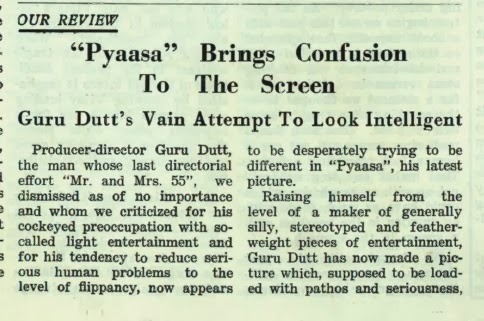
P.S. an earlier post that serendipitously begins with references to both Nirupa Roy and Pyaasa is here.
Couldn’t go through as many issues as I would have liked, but there was time enough to note that Mr Patel really did seem to enjoy mocking poor Nirupa Roy in the mid-50s (she was a couple of decades away from her iconic “mother” roles, but was well known for playing homely bhabhis in family dramas, or pious characters in mythological films). When I fondly called her a land mammal in this essay, I feared it might be considered disrespectful, but Baburao Patel was in on the act decades earlier: I saw at least eight photos of Ms Roy with sarcastic captions. Here are just two (both from the same issue of the magazine):


(Click pics to enlarge)
And as a bonus, the opening page (with headline and intro) of Film India’s review of the just-released Pyaasa:

P.S. an earlier post that serendipitously begins with references to both Nirupa Roy and Pyaasa is here.
Published on January 11, 2014 01:25
December 30, 2013
Stuart Little and the Pandavas in the house of lac
Imagine my delight when I checked the Tata Sky synopses for this week’s episodes of the Mahabharat and saw the following summary for Wednesday (episode 77):

Now I feel like I have a moral responsibility to write similar 3-sentence synopses for future episodes: the first sentence should be a non-sequitur, or at least have no obvious connection with the main narrative, while the remaining two sentences should solemnly continue the plot at snail’s pace. For example –
Episode 78: Bhima and the rat jive to the beat of “I'm Alive”. The Pandavas wonder why the walls smell of oil and fat. Vidura tells his men to dig a tunnel.
Episode 79: Vyasa is very angry with the Star Plus writers. Sahadeva says there is no smoke without fire. The Pandavas uncover the plot to burn down the palace with them in it.
 Episode 80: Arjuna goes for target practice, but someone with sharp teeth has nibbled through the bow-string. Vidura informs Bheeshma about his plan. Bheeshma sighs deeply.
Episode 80: Arjuna goes for target practice, but someone with sharp teeth has nibbled through the bow-string. Vidura informs Bheeshma about his plan. Bheeshma sighs deeply.
Episode 81: The rat considers moving somewhere safer, like the Bigg Boss house. The tunnel is half-finished. The workers take a lunch break and discuss the wickedness of the Kauravas.
Episode 82: Devdutt Pattanaik tells the rat dharma is subtle. Shakuni sends Purochana another secret message. Yudhisthira adjusts his crown and wonders if he should light a candle.
Teaser for the week after: Will the mouse douse the burning house? Find out in episode 83! Or episode 95!
(And so on. Feel free to weigh in. The epic is limitless and malleable, we must keep adding to it.)
[An earlier post: Karna and Kryptonite]

Now I feel like I have a moral responsibility to write similar 3-sentence synopses for future episodes: the first sentence should be a non-sequitur, or at least have no obvious connection with the main narrative, while the remaining two sentences should solemnly continue the plot at snail’s pace. For example –
Episode 78: Bhima and the rat jive to the beat of “I'm Alive”. The Pandavas wonder why the walls smell of oil and fat. Vidura tells his men to dig a tunnel.
Episode 79: Vyasa is very angry with the Star Plus writers. Sahadeva says there is no smoke without fire. The Pandavas uncover the plot to burn down the palace with them in it.
 Episode 80: Arjuna goes for target practice, but someone with sharp teeth has nibbled through the bow-string. Vidura informs Bheeshma about his plan. Bheeshma sighs deeply.
Episode 80: Arjuna goes for target practice, but someone with sharp teeth has nibbled through the bow-string. Vidura informs Bheeshma about his plan. Bheeshma sighs deeply. Episode 81: The rat considers moving somewhere safer, like the Bigg Boss house. The tunnel is half-finished. The workers take a lunch break and discuss the wickedness of the Kauravas.
Episode 82: Devdutt Pattanaik tells the rat dharma is subtle. Shakuni sends Purochana another secret message. Yudhisthira adjusts his crown and wonders if he should light a candle.
Teaser for the week after: Will the mouse douse the burning house? Find out in episode 83! Or episode 95!
(And so on. Feel free to weigh in. The epic is limitless and malleable, we must keep adding to it.)
[An earlier post: Karna and Kryptonite]
Published on December 30, 2013 07:53
December 28, 2013
A memory of Farooque Shaikh
Less than a week before I heard the saddening – and most unexpected – news of Farooque Shaikh’s passing, an SMS written in a familiar style lit up my phone screen. “Adaab,” it said. “Wish u a Merry Christmas, a Joyous New Year and a v happy life ahead. Best luck, always.” A few minutes later, the same message arrived again. This could have been a network glitch, but having seen Mr Shaikh (or Farooque saab, as it seems more apt to call him) a few weeks earlier, wrestling with and frowning at his handset – something I can often relate to – I could picture him having re-sent it accidentally.
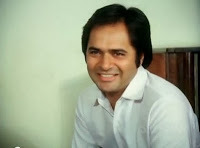 Either way, I had become used to the courtliness of his SMSes (even when written in shorthand) in the previous two months, ever since I first contacted him in connection with a writing project. In mid-October I had texted him – in the supplicating tone of a journalist seeking a few minutes of an Important Person’s time – asking if we could speak for a short while; on the phone would be fine. He replied with an “Adaab sir”, adding that he happened to be coming to Delhi at the end of the week, and it “wd be a plzre” to meet then “at a mutually cnvnnt time”.
Either way, I had become used to the courtliness of his SMSes (even when written in shorthand) in the previous two months, ever since I first contacted him in connection with a writing project. In mid-October I had texted him – in the supplicating tone of a journalist seeking a few minutes of an Important Person’s time – asking if we could speak for a short while; on the phone would be fine. He replied with an “Adaab sir”, adding that he happened to be coming to Delhi at the end of the week, and it “wd be a plzre” to meet then “at a mutually cnvnnt time”.
We met, and it was a pleasure – for me, at least – even though the conversation was short and unexceptional. He was everything you’d expect from his screen persona, warm and unfailingly polite in his direct addresses, though he did get a little agitated when he spoke more generally about falling standards in popular culture. I had a couple of specific talking points to cover, but we were quickly done with those, and for the next half-hour he talked mainly about how commerce had completely taken over the film world, and expressed annoyance about the hegemony of the Rs 200-300-crore cinema. “Vaahiyaat filmein agar 300 crore ka business kar rahe hain, toh aur log aa jaayenge, and they will go down the same route.”
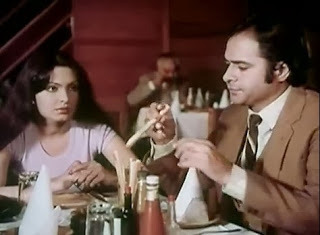 Much of what he said – if you simply transcribed it – would read as relentless complaining, and I didn’t agree with all of it. Some of it mixed deep idealism, a yearning for a fabled past where things were always so much better than today, and (in the context of his thoughts on “good” and “bad” cinema) a narrow view of the relationship between subject and form. There were capricious asides: while making the (reasonable) point about Hollywood’s technical excellence masking deficiencies in content and not allowing any other type of film to get breathing space, he suddenly brought up films “jiss mein spaceship yun zor zor se awaaz karti hai, phir girne lagti hai – whereas it is a basic fact of zero gravity that a spaceship will not fall like that even if it breaks up.” And he clearly wasn’t a fan of Jaws and the summer-blockbuster culture it spawned: “Ya toh ek machli aisi hai jo logon ko khaamakhaa marne lagti hai. This kind of stupidity has to stop.”
Much of what he said – if you simply transcribed it – would read as relentless complaining, and I didn’t agree with all of it. Some of it mixed deep idealism, a yearning for a fabled past where things were always so much better than today, and (in the context of his thoughts on “good” and “bad” cinema) a narrow view of the relationship between subject and form. There were capricious asides: while making the (reasonable) point about Hollywood’s technical excellence masking deficiencies in content and not allowing any other type of film to get breathing space, he suddenly brought up films “jiss mein spaceship yun zor zor se awaaz karti hai, phir girne lagti hai – whereas it is a basic fact of zero gravity that a spaceship will not fall like that even if it breaks up.” And he clearly wasn’t a fan of Jaws and the summer-blockbuster culture it spawned: “Ya toh ek machli aisi hai jo logon ko khaamakhaa marne lagti hai. This kind of stupidity has to stop.”
But the discontent came from his strong views on the relationship between a society and its popular culture, and his keenness to fix responsibility. “Cinema is a willing or unwilling appendage to society, so we may as well have some quality in it. Otherwise it’s like saying ‘Naashta toh mujhe karna hi hai, sada hua bhi chalega.’ But why not have a good meal, even if it is a small one? You risk your health if you eat chaat all the time. And then we complain ‘hamaaray society mein auraton ke saath yeh hota hai.’ You can’t pretend that cinema doesn’t have an effect on our minds – it’s a big thing.”
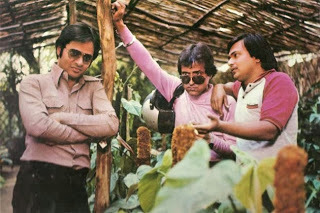 It wasn’t all about venting though. The meeting reminded me of conversations I had had with other, very likable men of integrity of his generation, Kundan Shah and the late Ravi Baswani – a tone that combined irritation and frustration with the ability to step back after a while and crack a quiet joke about one’s own irritability. And a genuine, boyish curiosity about what the younger person sitting in front of them felt about these things. (I have memories of Kundan, Ravi and Farooque saab – separately, of course – pausing for breath after a rant, then chuckling and asking a version of the question “Do you agree with any of this? Or could it be that I feel this way only because main budhaa ho gaya hoon?” And the question was asked sincerely, not rhetorically.)
It wasn’t all about venting though. The meeting reminded me of conversations I had had with other, very likable men of integrity of his generation, Kundan Shah and the late Ravi Baswani – a tone that combined irritation and frustration with the ability to step back after a while and crack a quiet joke about one’s own irritability. And a genuine, boyish curiosity about what the younger person sitting in front of them felt about these things. (I have memories of Kundan, Ravi and Farooque saab – separately, of course – pausing for breath after a rant, then chuckling and asking a version of the question “Do you agree with any of this? Or could it be that I feel this way only because main budhaa ho gaya hoon?” And the question was asked sincerely, not rhetorically.)
Farooque saab spoke with pragmatism (“it is unreal, and perhaps even unfair, to expect that a filmmaker is going to do good to society at a loss to himself”) but perhaps had an unrealistic view of the power wielded by the “thinking” audience (“...and so the discerning viewer has to make his presence felt. With the internet you can get back to the filmmaker immediately if he has made a bad or bawdy film, and tell him off. He will take that seriously. He depends on the ticket that the viewer buys.”) He moved between optimism and cynicism (“But as is the norm all over the world, the major audience is males aged between 15 and 25 years. They are the ones who decide whether a film will run or not”) and used humorous analogies: “Aaj kal ke movie reviews mein star ratings aise bikhte hain jaise langar mein khaana bikh raha ho.” And “You know the Sea Link in Mumbai? It cuts down travel time dramatically while you are on it – but when you exit it you’re in trouble again. That’s how the industry today is. Film toh complete ho jaati hai but then the intelligent, sincere filmmaker is in a surrounding that he cannot control: agar 3,500 screen kisi big-budget film ne le liye hain, then you get the one or two remaining shows, and the show time is such that your own wife won’t go for it.”
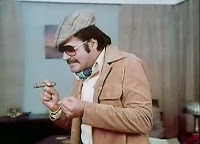 Near the end of our chat, he – consciously or otherwise – used an analogy closely linked to the plot of one of his most beloved movies. “There are two people in the race – the sprinter and the evening walker,” he said, marking the difference between money-obsessed filmmakers and the ones with a social conscience. “The promenade walker will not get ahead because he isn’t in it for the race, he’s out for a stroll – the sprinter is the one who wants to get ahead, and he will always win.”
Near the end of our chat, he – consciously or otherwise – used an analogy closely linked to the plot of one of his most beloved movies. “There are two people in the race – the sprinter and the evening walker,” he said, marking the difference between money-obsessed filmmakers and the ones with a social conscience. “The promenade walker will not get ahead because he isn’t in it for the race, he’s out for a stroll – the sprinter is the one who wants to get ahead, and he will always win.”
In Sai Paranjpye’s Katha , based on the hare-and-tortoise fable, he was cast against type as the wily hare (or the sprinter). I alluded to the film and he merely nodded and gave a quick smile, not pursuing the point – he wasn’t much interested in talking about his own movies, or at least his contribution to them. When he brought up Listen…Amaya – as another low-budget film that was released in only a couple of halls – this is what he said: “Recently ek film thi, Listen... Amaya, jiss mein Deepti ji aur Swara Bhaskar thay...” No mention of himself.
Which may be a reminder that he wasn’t “in it for the race” himself. I have no doubt that he took a project seriously once he had committed to it, but he came across as being blasé about his own career, unconcerned with such things as staying in the public memory. Still, he had done some fine work in the past couple of years – in Shanghai, Listen…Amaya, even in his short part in Yeh Jawani hai Diwani – and there may have been more to come.
Still, he had done some fine work in the past couple of years – in Shanghai, Listen…Amaya, even in his short part in Yeh Jawani hai Diwani – and there may have been more to come.
I don’t usually get too affected by the deaths of public figures, even those whose work or achievements I admired. But this was a little different, because of the immediacy of having met him so recently, and because he was too young. Notwithstanding his own indifference to fame or plaudits, with the right mix of subject, writer and director he might easily have had a notable second innings as a screen actor. For now, we have the past work: old favourites like Chashme Buddoor and Katha, of course, but also films like Gaman (now available in a restored NFDC print) and Saath Saath, which deserve to be revisited and rediscovered. And I have the rueful knowledge that despite having had opportunities, I never got around to seeing a performance of Tumhari Amrita .
[Related posts: a tribute to Ravi Baswani, Shaikh’s co-star in Chashme Buddoor; a review of Sai Paranjpye’s Katha; a piece about Listen Amaya, and about watching Shaikh and Deepti Naval on screen together after all these years. And on two excellent films in which Shaikh had small parts, 40 years apart: Garm Hava and Shanghai]
 Either way, I had become used to the courtliness of his SMSes (even when written in shorthand) in the previous two months, ever since I first contacted him in connection with a writing project. In mid-October I had texted him – in the supplicating tone of a journalist seeking a few minutes of an Important Person’s time – asking if we could speak for a short while; on the phone would be fine. He replied with an “Adaab sir”, adding that he happened to be coming to Delhi at the end of the week, and it “wd be a plzre” to meet then “at a mutually cnvnnt time”.
Either way, I had become used to the courtliness of his SMSes (even when written in shorthand) in the previous two months, ever since I first contacted him in connection with a writing project. In mid-October I had texted him – in the supplicating tone of a journalist seeking a few minutes of an Important Person’s time – asking if we could speak for a short while; on the phone would be fine. He replied with an “Adaab sir”, adding that he happened to be coming to Delhi at the end of the week, and it “wd be a plzre” to meet then “at a mutually cnvnnt time”.We met, and it was a pleasure – for me, at least – even though the conversation was short and unexceptional. He was everything you’d expect from his screen persona, warm and unfailingly polite in his direct addresses, though he did get a little agitated when he spoke more generally about falling standards in popular culture. I had a couple of specific talking points to cover, but we were quickly done with those, and for the next half-hour he talked mainly about how commerce had completely taken over the film world, and expressed annoyance about the hegemony of the Rs 200-300-crore cinema. “Vaahiyaat filmein agar 300 crore ka business kar rahe hain, toh aur log aa jaayenge, and they will go down the same route.”
 Much of what he said – if you simply transcribed it – would read as relentless complaining, and I didn’t agree with all of it. Some of it mixed deep idealism, a yearning for a fabled past where things were always so much better than today, and (in the context of his thoughts on “good” and “bad” cinema) a narrow view of the relationship between subject and form. There were capricious asides: while making the (reasonable) point about Hollywood’s technical excellence masking deficiencies in content and not allowing any other type of film to get breathing space, he suddenly brought up films “jiss mein spaceship yun zor zor se awaaz karti hai, phir girne lagti hai – whereas it is a basic fact of zero gravity that a spaceship will not fall like that even if it breaks up.” And he clearly wasn’t a fan of Jaws and the summer-blockbuster culture it spawned: “Ya toh ek machli aisi hai jo logon ko khaamakhaa marne lagti hai. This kind of stupidity has to stop.”
Much of what he said – if you simply transcribed it – would read as relentless complaining, and I didn’t agree with all of it. Some of it mixed deep idealism, a yearning for a fabled past where things were always so much better than today, and (in the context of his thoughts on “good” and “bad” cinema) a narrow view of the relationship between subject and form. There were capricious asides: while making the (reasonable) point about Hollywood’s technical excellence masking deficiencies in content and not allowing any other type of film to get breathing space, he suddenly brought up films “jiss mein spaceship yun zor zor se awaaz karti hai, phir girne lagti hai – whereas it is a basic fact of zero gravity that a spaceship will not fall like that even if it breaks up.” And he clearly wasn’t a fan of Jaws and the summer-blockbuster culture it spawned: “Ya toh ek machli aisi hai jo logon ko khaamakhaa marne lagti hai. This kind of stupidity has to stop.”But the discontent came from his strong views on the relationship between a society and its popular culture, and his keenness to fix responsibility. “Cinema is a willing or unwilling appendage to society, so we may as well have some quality in it. Otherwise it’s like saying ‘Naashta toh mujhe karna hi hai, sada hua bhi chalega.’ But why not have a good meal, even if it is a small one? You risk your health if you eat chaat all the time. And then we complain ‘hamaaray society mein auraton ke saath yeh hota hai.’ You can’t pretend that cinema doesn’t have an effect on our minds – it’s a big thing.”
 It wasn’t all about venting though. The meeting reminded me of conversations I had had with other, very likable men of integrity of his generation, Kundan Shah and the late Ravi Baswani – a tone that combined irritation and frustration with the ability to step back after a while and crack a quiet joke about one’s own irritability. And a genuine, boyish curiosity about what the younger person sitting in front of them felt about these things. (I have memories of Kundan, Ravi and Farooque saab – separately, of course – pausing for breath after a rant, then chuckling and asking a version of the question “Do you agree with any of this? Or could it be that I feel this way only because main budhaa ho gaya hoon?” And the question was asked sincerely, not rhetorically.)
It wasn’t all about venting though. The meeting reminded me of conversations I had had with other, very likable men of integrity of his generation, Kundan Shah and the late Ravi Baswani – a tone that combined irritation and frustration with the ability to step back after a while and crack a quiet joke about one’s own irritability. And a genuine, boyish curiosity about what the younger person sitting in front of them felt about these things. (I have memories of Kundan, Ravi and Farooque saab – separately, of course – pausing for breath after a rant, then chuckling and asking a version of the question “Do you agree with any of this? Or could it be that I feel this way only because main budhaa ho gaya hoon?” And the question was asked sincerely, not rhetorically.)Farooque saab spoke with pragmatism (“it is unreal, and perhaps even unfair, to expect that a filmmaker is going to do good to society at a loss to himself”) but perhaps had an unrealistic view of the power wielded by the “thinking” audience (“...and so the discerning viewer has to make his presence felt. With the internet you can get back to the filmmaker immediately if he has made a bad or bawdy film, and tell him off. He will take that seriously. He depends on the ticket that the viewer buys.”) He moved between optimism and cynicism (“But as is the norm all over the world, the major audience is males aged between 15 and 25 years. They are the ones who decide whether a film will run or not”) and used humorous analogies: “Aaj kal ke movie reviews mein star ratings aise bikhte hain jaise langar mein khaana bikh raha ho.” And “You know the Sea Link in Mumbai? It cuts down travel time dramatically while you are on it – but when you exit it you’re in trouble again. That’s how the industry today is. Film toh complete ho jaati hai but then the intelligent, sincere filmmaker is in a surrounding that he cannot control: agar 3,500 screen kisi big-budget film ne le liye hain, then you get the one or two remaining shows, and the show time is such that your own wife won’t go for it.”
 Near the end of our chat, he – consciously or otherwise – used an analogy closely linked to the plot of one of his most beloved movies. “There are two people in the race – the sprinter and the evening walker,” he said, marking the difference between money-obsessed filmmakers and the ones with a social conscience. “The promenade walker will not get ahead because he isn’t in it for the race, he’s out for a stroll – the sprinter is the one who wants to get ahead, and he will always win.”
Near the end of our chat, he – consciously or otherwise – used an analogy closely linked to the plot of one of his most beloved movies. “There are two people in the race – the sprinter and the evening walker,” he said, marking the difference between money-obsessed filmmakers and the ones with a social conscience. “The promenade walker will not get ahead because he isn’t in it for the race, he’s out for a stroll – the sprinter is the one who wants to get ahead, and he will always win.”In Sai Paranjpye’s Katha , based on the hare-and-tortoise fable, he was cast against type as the wily hare (or the sprinter). I alluded to the film and he merely nodded and gave a quick smile, not pursuing the point – he wasn’t much interested in talking about his own movies, or at least his contribution to them. When he brought up Listen…Amaya – as another low-budget film that was released in only a couple of halls – this is what he said: “Recently ek film thi, Listen... Amaya, jiss mein Deepti ji aur Swara Bhaskar thay...” No mention of himself.
Which may be a reminder that he wasn’t “in it for the race” himself. I have no doubt that he took a project seriously once he had committed to it, but he came across as being blasé about his own career, unconcerned with such things as staying in the public memory.
 Still, he had done some fine work in the past couple of years – in Shanghai, Listen…Amaya, even in his short part in Yeh Jawani hai Diwani – and there may have been more to come.
Still, he had done some fine work in the past couple of years – in Shanghai, Listen…Amaya, even in his short part in Yeh Jawani hai Diwani – and there may have been more to come. I don’t usually get too affected by the deaths of public figures, even those whose work or achievements I admired. But this was a little different, because of the immediacy of having met him so recently, and because he was too young. Notwithstanding his own indifference to fame or plaudits, with the right mix of subject, writer and director he might easily have had a notable second innings as a screen actor. For now, we have the past work: old favourites like Chashme Buddoor and Katha, of course, but also films like Gaman (now available in a restored NFDC print) and Saath Saath, which deserve to be revisited and rediscovered. And I have the rueful knowledge that despite having had opportunities, I never got around to seeing a performance of Tumhari Amrita .
[Related posts: a tribute to Ravi Baswani, Shaikh’s co-star in Chashme Buddoor; a review of Sai Paranjpye’s Katha; a piece about Listen Amaya, and about watching Shaikh and Deepti Naval on screen together after all these years. And on two excellent films in which Shaikh had small parts, 40 years apart: Garm Hava and Shanghai]
Published on December 28, 2013 23:40
December 21, 2013
Love and longing in Prague - on Nirmal Verma's वे दिन
[Did this piece for the Sunday Guardian]
-------------
“Happiness always takes us by surprise, or perhaps it is not happiness. It is one’s unhappiness diminished in size.”
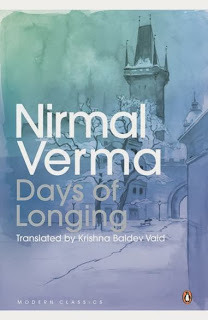 Is this a happy book or a sad book? The question sounds trite and reductive, but it leapt to mind as I turned the last page of Nirmal Verma’s Days of Longing, an English translation - by Krishna Baldev Vaid - of the 1964 novel वे दिन, now out in a new edition by Penguin’s Modern Classics. Depending on one’s perspective (and possibly depending on what stage of life one is in), this could be an essentially sad story disguised as something brighter, or the converse, a breezy, slice-of-life tale pretending to be a tragic love story. Either way, this is among the most moving novels I have read in a while – and in one sense at least, among the most unusual.
Is this a happy book or a sad book? The question sounds trite and reductive, but it leapt to mind as I turned the last page of Nirmal Verma’s Days of Longing, an English translation - by Krishna Baldev Vaid - of the 1964 novel वे दिन, now out in a new edition by Penguin’s Modern Classics. Depending on one’s perspective (and possibly depending on what stage of life one is in), this could be an essentially sad story disguised as something brighter, or the converse, a breezy, slice-of-life tale pretending to be a tragic love story. Either way, this is among the most moving novels I have read in a while – and in one sense at least, among the most unusual.Here is a book by an Indian writer, about an Indian student who has lived in cold Prague for over two years, and is spending the Christmas holidays (a time of year when overseas students typically go home) in the city, with the few friends who are still around: among them a Burmese student named Than Thun (TT), a restless German named Franz, who is studying cinematography but getting nowhere, and Franz’s girlfriend Maria, who is unable to get the visa that will allow her to leave the country with him. Much of their time is spent visiting pubs or lolling about in their gloomy hostel, drinking vodka or beer or sherry almost throughout the day, not so much to get drunk as to stay warm (as in so many Eastern European novels, the weather seems a constant factor in the characters’ lives, informing their actions and attitudes). They often go without hot water and don’t seem to sleep for more than a couple of hours, but subsist – more or less cheerfully – in each other’s company; they joke about living in “the city of empty pockets and full bladders” (because there are very few public urinals).
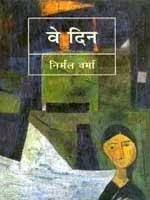 And through all this, the Indianness of the unnamed narrator-protagonist scarcely seems a factor at all***. For a reader used to the many soul-searching narratives about displacement or exile in Indian English fiction, this can be startling. We learn nothing about this young man’s family, his background, even which part of India he comes from. (For the longest time, I didn’t picture him as Indian at all; instead, drawing on a prior reference point for a story set in Czechoslovakia, I saw him as a version of the wide-eyed, sallow-complexioned Milos in the film
Closely Watched Trains
.) There is a mention of a letter from home, which he isn’t eager to open (“I remembered that I had not yet read my sister’s letter, but then I remembered that there was no light. I felt happy at the thought that I wouldn’t have to read it that night”), but it isn’t the case that something dramatic led him to “escape” to a foreign land – it is more as if he has settled into a cocoon beyond ideas of country or culture or nostalgia, a cocoon woven around new friendships. “We had left home at a stage when our childhood connections had been cut off and we hadn’t yet forged adult links with people and places,” he tells us, speaking of himself and TT, “Our homes seemed unreal from afar, like someone else’s homes, alien memories. They seemed meaningless, even ridiculous.”
And through all this, the Indianness of the unnamed narrator-protagonist scarcely seems a factor at all***. For a reader used to the many soul-searching narratives about displacement or exile in Indian English fiction, this can be startling. We learn nothing about this young man’s family, his background, even which part of India he comes from. (For the longest time, I didn’t picture him as Indian at all; instead, drawing on a prior reference point for a story set in Czechoslovakia, I saw him as a version of the wide-eyed, sallow-complexioned Milos in the film
Closely Watched Trains
.) There is a mention of a letter from home, which he isn’t eager to open (“I remembered that I had not yet read my sister’s letter, but then I remembered that there was no light. I felt happy at the thought that I wouldn’t have to read it that night”), but it isn’t the case that something dramatic led him to “escape” to a foreign land – it is more as if he has settled into a cocoon beyond ideas of country or culture or nostalgia, a cocoon woven around new friendships. “We had left home at a stage when our childhood connections had been cut off and we hadn’t yet forged adult links with people and places,” he tells us, speaking of himself and TT, “Our homes seemed unreal from afar, like someone else’s homes, alien memories. They seemed meaningless, even ridiculous.”Into this languid, drifting life comes the seed of a “plot” when the narrator (I’ll call him Indy for convenience, as his friends sometimes do) gets a temporary job as an interpreter for an Austrian woman named Raina and her little son. Indy and Raina grow close, and over the three days they spend together he experiences a range of emotions, swelling, then subsiding and swelling again: from hesitance and doubt to intense longing and awareness of hours spent apart, to quiet jealousy and possessiveness, built on the knowledge that her previous visit to Prague had been in the company of her now-estranged husband Jacques, and that she may be attempting to relive it by going to the same spots again.
“It bothered me,” he says, “I wanted her to look at everything for the first time. But she seemed to be keen about revisiting places she had already seen.” And then the simple yet powerful pathos of this line: “After knowing some people, one can’t help feeling one’s met them a bit too late.”
“It wasn’t age that separated us. It was her past, completely concealed from my knowledge. There are houses that you can’t really enter even through their wide open doors. They are alien, unpossessable.”
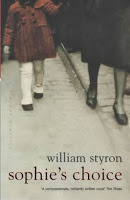 These could be the thoughts of anyone who has wondered about a lover’s romantic history, but here they also have to do with Raina’s experiences in the Second World War. It occurred to me that with a shift in narrative focus, this novel would strongly resemble William Styron’s
Sophie’s Choice
(which came 15 years later), about a young man besotted by an older woman but also permanently cut off from her by the terrible things she went through in the past, and unable to compete with the ineradicable, sado-masochistic relationship she has with the man who shared that past with her.
These could be the thoughts of anyone who has wondered about a lover’s romantic history, but here they also have to do with Raina’s experiences in the Second World War. It occurred to me that with a shift in narrative focus, this novel would strongly resemble William Styron’s
Sophie’s Choice
(which came 15 years later), about a young man besotted by an older woman but also permanently cut off from her by the terrible things she went through in the past, and unable to compete with the ineradicable, sado-masochistic relationship she has with the man who shared that past with her.Days of Longing is not as obviously driven by political events as Styron's novel – it is sparer, more abstract, more concerned with a young man’s interior life than with larger histories. Yet the shadows of those histories do loom in the background: in the brief allusions to WWII (Raina makes the strange but believable admission that her relationship with her husband, secure when they were living in turbulent, war-fractured times, began to dissolve when peace arrived), but also in the little reminders – through the parallel story of Franz and Maria, or a reference to a sad, accordion-playing hostel inmate who can’t go home to Belgrade to be with his family – of troubled relations between the European countries in the present day of the narrative. Throughout, there is a sense of how the personal is affected by the political.
And hanging over Indy and Raina is the knowledge of how short-lived their relationship is. In a sense, all their time together is preparation for being separated (not unlike the lovers in Richard Linklater’s Before Sunrise ) and the very temporariness makes it more intense, making him more aware of the need to hold on to things and remember them; to be seduced by the idea of love rather than the tangible presence of it. (“Remember the day we went to the skating rink?” she asks. It is an oddly put question on the face of it, since it refers to something that happened only 48 hours earlier. Yet it makes sense – they are trying to fit a lifetime of longing into this short period.)
In fact, a possible key to this book’s mysteries is a description of love as a temporary respite: “It was like an invisible fire that we could feel, that had been trying to pierce through our mutual darkness […] Three days or three years don’t make a difference unless we can catch hold of a burning moment in the darkness, knowing full well that it won’t last and after it is extinguished we will slide back into our own chilling solitude.” That burning moment set against darkness finds an echo elsewhere in the book. At one point Raina relates something she had once been told, about there being two kinds of happiness, big and small. Small happiness includes the warmth provided by fire or sherry, or the company of friends. “And the big happiness is to be able to breathe, just to be able to breathe in open air.” The words, tellingly, came from a Jewish man who was laughing and handing out cigarettes at the time, but was later killed by the Germans.
This elegant, hard-to-classify novel doesn’t quite provide a sense of closure or even development, which is why it is difficult to think of it as a coming-of-age story – it seems Indy’s life will continue along a circuit, much like the city’s trams gliding along their familiar routes (and perhaps I can call to mind here the ending of a favourite novel, also set in an Eastern European city, Kazuo Ishiguro’s The Unconsoled). But perhaps his time with Raina has helped him come to terms with the crucial idea of “small” happiness, and the possibility that this romance, so all-encompassing while it unfolded, could in the larger view of things be just another addition to that list. Most of all, perhaps the lesson he is learning is that there may not be anything so grand or lasting as a big happiness.
-------------
*** Of course, the question arises: if one were reading this book in the original Hindi, would it be possible to "forget" or disregard Indy's Indianness? I imagine not, having read an excerpt from वे दिन on Pustak.org.
P.S.Krishna Baldev Vaid, a renowned writer himself, was a contemporary and sometime friend of Nirmal Verma; for a sense of Vaid’s often-ambivalent feelings about Verma and his work, read this tribute.
P.P.S. The Modern Classics imprint also has a new edition of The Red Tin Roof , a translation of Verma's लाल टीन की छत
Published on December 21, 2013 07:16
December 19, 2013
Notes from the Star Plus Mahabharata: Kryptonite Karna
I have been following the new Star Plus Mahabharata fairly closely, a process made easier by the fact that each episode is uploaded on YouTube a day after the telecast (though the more flamboyant action scenes are better seen on H-D TV). The show has its problems – as any five-day-a-week Mahabharata would – but it definitely isn’t bad, or unintentionally funny, in the way that Ekta Kapoor’s shoddy Kahaani Hamaaray Mahabharat Ki was***. Hope to do an extended post about it at some point (have written something in an essay for a magazine, which I will put up here soon), but for now a quick note about certain inventive things they have done to Karna. His impenetrable kavacha (armour) isn't permanently attached to his
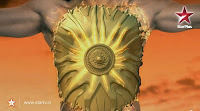 body, as in the original epic. Instead it appears only in specific moments of crisis – when an arrow is headed for his chest, for instance. In this episode, you can see this happen twice: first, with the teenage Karna, around the four-minute mark; then with the first appearance of the adult Karna at the end of the episode, when a flaming thing comes at him out of the artificial sun he has created with his astra. (Yes!)
body, as in the original epic. Instead it appears only in specific moments of crisis – when an arrow is headed for his chest, for instance. In this episode, you can see this happen twice: first, with the teenage Karna, around the four-minute mark; then with the first appearance of the adult Karna at the end of the episode, when a flaming thing comes at him out of the artificial sun he has created with his astra. (Yes!)
These scenes put me in mind of modern comic-book superheroes with their secret powers – Clark Kent turning into Superman in the phone booth – and tight costumes worn over muscular abdomens. But there are parallels anyway: the Superman back-story has baby Kal-El being encased in a protective bubble by his father, much like Karna gets his kavacha from his divine daddy Surya. Watch this scene from the 1978 Superman and tell me you don’t recognise other rudiments of the story: the child being sent away by tearful parents (Marlon Brando as Kunti, who would’ve thunk?); the foster-parents being unable to come to grips with the apparently superhuman gifts of the infant they have raised in their humble home. And the armour will also turn out to be Karna’s Kryptonite when he has to give it away later in the tale. Another reminder that modern mythologies are so often derivative of ancient ones.
anyway: the Superman back-story has baby Kal-El being encased in a protective bubble by his father, much like Karna gets his kavacha from his divine daddy Surya. Watch this scene from the 1978 Superman and tell me you don’t recognise other rudiments of the story: the child being sent away by tearful parents (Marlon Brando as Kunti, who would’ve thunk?); the foster-parents being unable to come to grips with the apparently superhuman gifts of the infant they have raised in their humble home. And the armour will also turn out to be Karna’s Kryptonite when he has to give it away later in the tale. Another reminder that modern mythologies are so often derivative of ancient ones.
P.S. that episode I linked to also features Puneet Issar as Parashurama, allowing doddering folks of my vintage to feel deeply nostalgic about his performance as Duryodhana 25 years ago.
*** Some posts about Kahaani Hamaaray Mahabharat Ki: 1, 2, 3, 4, 5, 6
Also, an old post that ponders the important question: why did Karna need to borrow vinegar from hairy and characterless women?
 body, as in the original epic. Instead it appears only in specific moments of crisis – when an arrow is headed for his chest, for instance. In this episode, you can see this happen twice: first, with the teenage Karna, around the four-minute mark; then with the first appearance of the adult Karna at the end of the episode, when a flaming thing comes at him out of the artificial sun he has created with his astra. (Yes!)
body, as in the original epic. Instead it appears only in specific moments of crisis – when an arrow is headed for his chest, for instance. In this episode, you can see this happen twice: first, with the teenage Karna, around the four-minute mark; then with the first appearance of the adult Karna at the end of the episode, when a flaming thing comes at him out of the artificial sun he has created with his astra. (Yes!) These scenes put me in mind of modern comic-book superheroes with their secret powers – Clark Kent turning into Superman in the phone booth – and tight costumes worn over muscular abdomens. But there are parallels
 anyway: the Superman back-story has baby Kal-El being encased in a protective bubble by his father, much like Karna gets his kavacha from his divine daddy Surya. Watch this scene from the 1978 Superman and tell me you don’t recognise other rudiments of the story: the child being sent away by tearful parents (Marlon Brando as Kunti, who would’ve thunk?); the foster-parents being unable to come to grips with the apparently superhuman gifts of the infant they have raised in their humble home. And the armour will also turn out to be Karna’s Kryptonite when he has to give it away later in the tale. Another reminder that modern mythologies are so often derivative of ancient ones.
anyway: the Superman back-story has baby Kal-El being encased in a protective bubble by his father, much like Karna gets his kavacha from his divine daddy Surya. Watch this scene from the 1978 Superman and tell me you don’t recognise other rudiments of the story: the child being sent away by tearful parents (Marlon Brando as Kunti, who would’ve thunk?); the foster-parents being unable to come to grips with the apparently superhuman gifts of the infant they have raised in their humble home. And the armour will also turn out to be Karna’s Kryptonite when he has to give it away later in the tale. Another reminder that modern mythologies are so often derivative of ancient ones.P.S. that episode I linked to also features Puneet Issar as Parashurama, allowing doddering folks of my vintage to feel deeply nostalgic about his performance as Duryodhana 25 years ago.
*** Some posts about Kahaani Hamaaray Mahabharat Ki: 1, 2, 3, 4, 5, 6
Also, an old post that ponders the important question: why did Karna need to borrow vinegar from hairy and characterless women?
Published on December 19, 2013 09:48
December 14, 2013
A book about Sahir Ludhianvi
An early shout-out for
Sahir Ludhianvi: The People’s Poet
, written by Akshay Manwani and available for pre-order now. I have been following Akshay’s progress, on and off over the past few years, on what has been a labour of love for him, and am glad the book is finally ready: it should contribute to filling a gap in Indian writing in English, that of the serious biography of a modern cultural figure.
On December 18, I will be moderating a conversation with Akshay about the book at the India International Centre in Delhi: also on the panel is Gauhar Raza, the scientist and Urdu poet. The invite is below – do try to come, and spread the word to Sahir Ludhianvi fans. (Also, here are some links to Akshay’s long-form work on the Caravan website: profiles of Piyush Mishra and Irshad Kamil, as well as a piece about the 25th anniversary of the B R Chopra Mahabharata.)

On December 18, I will be moderating a conversation with Akshay about the book at the India International Centre in Delhi: also on the panel is Gauhar Raza, the scientist and Urdu poet. The invite is below – do try to come, and spread the word to Sahir Ludhianvi fans. (Also, here are some links to Akshay’s long-form work on the Caravan website: profiles of Piyush Mishra and Irshad Kamil, as well as a piece about the 25th anniversary of the B R Chopra Mahabharata.)

Published on December 14, 2013 21:25
December 10, 2013
On Jaspreet Singh's Helium, fiction as lecture, and the 1984 riots
[Did a shorter version of this for GQ India]
Being all of seven when the anti-Sikh riots following Indira Gandhi’s assassination took place, I don’t have vivid memories of the time, apart from knowing that my grandfather had to remove the “Singh” nameplate from outside our south Delhi residence. That must have been distressing enough for a proud man who had retired as a Brigadier in the Seventies, but it doesn’t compare to the horrors visited on other, less privileged – or less lucky – members of the community during those lawless days.
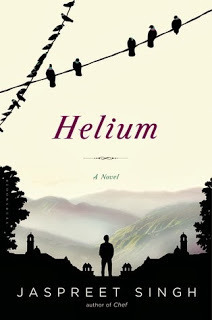 The writer Jaspreet Singh must have had a more immediate relationship with the tragedy: it is evident on nearly every angry, mournful page of his new novel
Helium
, written in the voice of a Hindu man returning to India after 25 years in the US. That quarter-century is a form of self-banishment: as a 19-year-old student in 1984, Raj witnessed the killing of his Sikh professor and later realised that his own father – a senior police officer – was complicit in the riots. But an even more complex guilt, rooted in Raj’s relationship with his professor’s attractive wife, may be at play. Now, decades later, he has returned to make sense of the past and possibly slay some of his demons. This is promising material for a novel, but Heliumtries to be too many things at once, which could be a pitfall inherent in its genre.
The writer Jaspreet Singh must have had a more immediate relationship with the tragedy: it is evident on nearly every angry, mournful page of his new novel
Helium
, written in the voice of a Hindu man returning to India after 25 years in the US. That quarter-century is a form of self-banishment: as a 19-year-old student in 1984, Raj witnessed the killing of his Sikh professor and later realised that his own father – a senior police officer – was complicit in the riots. But an even more complex guilt, rooted in Raj’s relationship with his professor’s attractive wife, may be at play. Now, decades later, he has returned to make sense of the past and possibly slay some of his demons. This is promising material for a novel, but Heliumtries to be too many things at once, which could be a pitfall inherent in its genre.
When fiction takes on real-world tragedies – especially manmade tragedies that are still fresh in the collective memory – it often happens that the grotesqueness of actual events becomes overwhelming; reality threatens to dwarf the novelist’s imaginative skills. This may be why so much writing of this sort moves beyond realist storytelling and employs surrealism, magic realism or jet-black humour: consider Mohammed Hanif’s A Case Of Exploding Mangoes , a dark satire about the twilight days of the Pakistani dictator Zia ul Haq, or Mario Vargas Llosa’s The Feast of the Goat , about another real-life tyrant, the Dominican Republic’s Rafael Trujillo, or Raj Kamal Jha’s ambitious but overwritten Fireproof , which approaches the 2002 Gujarat riots tangentially, using the metaphor of a father saddled with a deformed baby on the day after the Godhra killings. By being deliberately over the top, such books often provide a buffer for the reader, shielding us from the full-on assaults of hard reality. But it goes without saying that such flourishes are inherently risky things – very few writers can pull them off with consistent success.
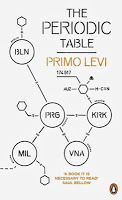 Heliummakes some intriguing stylistic choices too. Singh – who has studied chemical engineering – is deeply influenced by
The Periodic Table
, Primo Levi’s memoir about working as a chemist in fascist Germany: that book is an acknowledged guiding light for him, as he contrasts the shape and movements of chemical elements with the colliding paths and destinies of human beings. But the spirit of another major writer also inhabits these pages. Like W G Sebald, Singh is interested in the variability and unreliability of memory, and collective forgetfulness when it comes to human tragedies; like Sebald, he uses the method of interspersing text with black-and-white images, which testify to the inadequacy of mere writing when it comes to remembering. (Unlike Sebald, he links rheology – the study of the flow of matter – with the viscosity of memories, a natural enough association given Raj's profession and educational background.)
Heliummakes some intriguing stylistic choices too. Singh – who has studied chemical engineering – is deeply influenced by
The Periodic Table
, Primo Levi’s memoir about working as a chemist in fascist Germany: that book is an acknowledged guiding light for him, as he contrasts the shape and movements of chemical elements with the colliding paths and destinies of human beings. But the spirit of another major writer also inhabits these pages. Like W G Sebald, Singh is interested in the variability and unreliability of memory, and collective forgetfulness when it comes to human tragedies; like Sebald, he uses the method of interspersing text with black-and-white images, which testify to the inadequacy of mere writing when it comes to remembering. (Unlike Sebald, he links rheology – the study of the flow of matter – with the viscosity of memories, a natural enough association given Raj's profession and educational background.)
Reading Helium, I was also reminded of Indra Sinha’s Animal’s People, a fictionalised account of the aftermath of the Bhopal gas tragedy. Sinha’s novel, which begins with the words “I used to be human once”, is narrated by a misshapen youngster called Jaanvar because he walks on all fours. One can note that Raj in Helium is another stunted narrator – stunted not physically, but emotionally – and the best passages here are the ones where we sense the fragility of his hold over past and present, his fear that paranoia and guilt may have unbalanced his perceptions. The writing often has a breathless, quivering vulnerability, as if Raj is using a rush of words to mask his own uncertainties; the narrative is swamped in excessive detail, often provided in parentheses (such as a note about Raj’s sleeping habits and the colour of the kurta-pyjamas he has just been given to wear), which can become annoying if you take it at face value, but works if you consider the fevered mental state of this man.
But stimulating as this book is on some levels, I was discomfited by its use of a fictional framework for purposes that seem better left to reportage.
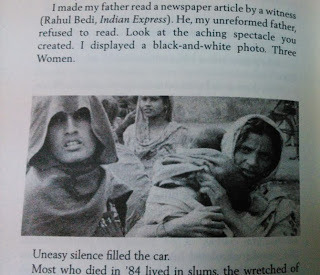 What good literary fiction in this genre can do is to show us, in abstract terms, how tragedies may occur through a confluence of character, circumstance and history. The emphasis is on uncovering poetic truths about people and situations, as distinct from investigative journalism, which is built on hard facts and explicitly sets out to name real names and ensure that justice is carried out. Helium blurs this distinction. It begins as a moving portrait of a man crippled by guilt (personal guilt as well as guilt by association – on behalf of his father, the hardliners in his community and ultimately even his country) but soon becomes a much more specific harangue against the Congress and the Nehru-Gandhi family. Using real people in a fictional narrative is not in itself a problem – Hanif’s novel, for instance, has brilliant comic passages such as the one where Zia ul Haq goes out into the streets in disguise at night – but Helium does this in a ham-fisted way that takes the reader right out of the story.
What good literary fiction in this genre can do is to show us, in abstract terms, how tragedies may occur through a confluence of character, circumstance and history. The emphasis is on uncovering poetic truths about people and situations, as distinct from investigative journalism, which is built on hard facts and explicitly sets out to name real names and ensure that justice is carried out. Helium blurs this distinction. It begins as a moving portrait of a man crippled by guilt (personal guilt as well as guilt by association – on behalf of his father, the hardliners in his community and ultimately even his country) but soon becomes a much more specific harangue against the Congress and the Nehru-Gandhi family. Using real people in a fictional narrative is not in itself a problem – Hanif’s novel, for instance, has brilliant comic passages such as the one where Zia ul Haq goes out into the streets in disguise at night – but Helium does this in a ham-fisted way that takes the reader right out of the story.
For instance, one important passage where Raj meets a Mr Gopal, an estranged friend of his father, who launches into a monologue about the political cover-up behind the riots, doesn’t read as something that flows organically from the narrative: instead the book grinds to a halt as Gopal Uncle lists the tyrannies of the Indira Gandhi government and the specifics of the riots, spits out phrases like “that failed aeronautical engineer Rajiv Gandhi (Mr Clean)...” and supplies pedantic commentary on the state of the nation in general (“We Indians call ourselves spiritual but we never give away a single rupee. We produce Tatas and Mittals and Ambanis and polyester princes and mining millionaires – while 500 million lead lives more impoverished than the most wretched in Africa”).
The point is not whether this is true (much of it is), or whether fictional characters should be allowed to express their own strident views (of course they should), but that Helium becomes less effective as a novel – as an exploration of Raj's interior life and his attempts at catharsis – at precisely the points where it makes these clumsy, long-winded detours into verisimilitude. It turns to documentation, narrating stories about real people such as the ministers Lalit Maken and H K L Bhagat (The same Congress leader, H K L Bhagat, who, according to witnesses, had ordered his men to kill thousands of Sikhs and rape the women, was now there in the camp distributing blankets and food […] I am unable to forget the face of that monster H K L Bhagat. Member of Parliament. Cabinet Minister. Ex-Mayor of Delhi), and introduces characters who aren’t so much properly realised people as obvious mouthpieces for the author. Watching this novel lose focus and direction is a lesson for writers attempting similar ventures, and a demonstration that well-intentioned lectures don’t usually leave much space for good storytelling.
P.S.I was unsurprised to read a laudatory international review that says:
Being all of seven when the anti-Sikh riots following Indira Gandhi’s assassination took place, I don’t have vivid memories of the time, apart from knowing that my grandfather had to remove the “Singh” nameplate from outside our south Delhi residence. That must have been distressing enough for a proud man who had retired as a Brigadier in the Seventies, but it doesn’t compare to the horrors visited on other, less privileged – or less lucky – members of the community during those lawless days.
 The writer Jaspreet Singh must have had a more immediate relationship with the tragedy: it is evident on nearly every angry, mournful page of his new novel
Helium
, written in the voice of a Hindu man returning to India after 25 years in the US. That quarter-century is a form of self-banishment: as a 19-year-old student in 1984, Raj witnessed the killing of his Sikh professor and later realised that his own father – a senior police officer – was complicit in the riots. But an even more complex guilt, rooted in Raj’s relationship with his professor’s attractive wife, may be at play. Now, decades later, he has returned to make sense of the past and possibly slay some of his demons. This is promising material for a novel, but Heliumtries to be too many things at once, which could be a pitfall inherent in its genre.
The writer Jaspreet Singh must have had a more immediate relationship with the tragedy: it is evident on nearly every angry, mournful page of his new novel
Helium
, written in the voice of a Hindu man returning to India after 25 years in the US. That quarter-century is a form of self-banishment: as a 19-year-old student in 1984, Raj witnessed the killing of his Sikh professor and later realised that his own father – a senior police officer – was complicit in the riots. But an even more complex guilt, rooted in Raj’s relationship with his professor’s attractive wife, may be at play. Now, decades later, he has returned to make sense of the past and possibly slay some of his demons. This is promising material for a novel, but Heliumtries to be too many things at once, which could be a pitfall inherent in its genre.When fiction takes on real-world tragedies – especially manmade tragedies that are still fresh in the collective memory – it often happens that the grotesqueness of actual events becomes overwhelming; reality threatens to dwarf the novelist’s imaginative skills. This may be why so much writing of this sort moves beyond realist storytelling and employs surrealism, magic realism or jet-black humour: consider Mohammed Hanif’s A Case Of Exploding Mangoes , a dark satire about the twilight days of the Pakistani dictator Zia ul Haq, or Mario Vargas Llosa’s The Feast of the Goat , about another real-life tyrant, the Dominican Republic’s Rafael Trujillo, or Raj Kamal Jha’s ambitious but overwritten Fireproof , which approaches the 2002 Gujarat riots tangentially, using the metaphor of a father saddled with a deformed baby on the day after the Godhra killings. By being deliberately over the top, such books often provide a buffer for the reader, shielding us from the full-on assaults of hard reality. But it goes without saying that such flourishes are inherently risky things – very few writers can pull them off with consistent success.
 Heliummakes some intriguing stylistic choices too. Singh – who has studied chemical engineering – is deeply influenced by
The Periodic Table
, Primo Levi’s memoir about working as a chemist in fascist Germany: that book is an acknowledged guiding light for him, as he contrasts the shape and movements of chemical elements with the colliding paths and destinies of human beings. But the spirit of another major writer also inhabits these pages. Like W G Sebald, Singh is interested in the variability and unreliability of memory, and collective forgetfulness when it comes to human tragedies; like Sebald, he uses the method of interspersing text with black-and-white images, which testify to the inadequacy of mere writing when it comes to remembering. (Unlike Sebald, he links rheology – the study of the flow of matter – with the viscosity of memories, a natural enough association given Raj's profession and educational background.)
Heliummakes some intriguing stylistic choices too. Singh – who has studied chemical engineering – is deeply influenced by
The Periodic Table
, Primo Levi’s memoir about working as a chemist in fascist Germany: that book is an acknowledged guiding light for him, as he contrasts the shape and movements of chemical elements with the colliding paths and destinies of human beings. But the spirit of another major writer also inhabits these pages. Like W G Sebald, Singh is interested in the variability and unreliability of memory, and collective forgetfulness when it comes to human tragedies; like Sebald, he uses the method of interspersing text with black-and-white images, which testify to the inadequacy of mere writing when it comes to remembering. (Unlike Sebald, he links rheology – the study of the flow of matter – with the viscosity of memories, a natural enough association given Raj's profession and educational background.)Reading Helium, I was also reminded of Indra Sinha’s Animal’s People, a fictionalised account of the aftermath of the Bhopal gas tragedy. Sinha’s novel, which begins with the words “I used to be human once”, is narrated by a misshapen youngster called Jaanvar because he walks on all fours. One can note that Raj in Helium is another stunted narrator – stunted not physically, but emotionally – and the best passages here are the ones where we sense the fragility of his hold over past and present, his fear that paranoia and guilt may have unbalanced his perceptions. The writing often has a breathless, quivering vulnerability, as if Raj is using a rush of words to mask his own uncertainties; the narrative is swamped in excessive detail, often provided in parentheses (such as a note about Raj’s sleeping habits and the colour of the kurta-pyjamas he has just been given to wear), which can become annoying if you take it at face value, but works if you consider the fevered mental state of this man.
But stimulating as this book is on some levels, I was discomfited by its use of a fictional framework for purposes that seem better left to reportage.
 What good literary fiction in this genre can do is to show us, in abstract terms, how tragedies may occur through a confluence of character, circumstance and history. The emphasis is on uncovering poetic truths about people and situations, as distinct from investigative journalism, which is built on hard facts and explicitly sets out to name real names and ensure that justice is carried out. Helium blurs this distinction. It begins as a moving portrait of a man crippled by guilt (personal guilt as well as guilt by association – on behalf of his father, the hardliners in his community and ultimately even his country) but soon becomes a much more specific harangue against the Congress and the Nehru-Gandhi family. Using real people in a fictional narrative is not in itself a problem – Hanif’s novel, for instance, has brilliant comic passages such as the one where Zia ul Haq goes out into the streets in disguise at night – but Helium does this in a ham-fisted way that takes the reader right out of the story.
What good literary fiction in this genre can do is to show us, in abstract terms, how tragedies may occur through a confluence of character, circumstance and history. The emphasis is on uncovering poetic truths about people and situations, as distinct from investigative journalism, which is built on hard facts and explicitly sets out to name real names and ensure that justice is carried out. Helium blurs this distinction. It begins as a moving portrait of a man crippled by guilt (personal guilt as well as guilt by association – on behalf of his father, the hardliners in his community and ultimately even his country) but soon becomes a much more specific harangue against the Congress and the Nehru-Gandhi family. Using real people in a fictional narrative is not in itself a problem – Hanif’s novel, for instance, has brilliant comic passages such as the one where Zia ul Haq goes out into the streets in disguise at night – but Helium does this in a ham-fisted way that takes the reader right out of the story.For instance, one important passage where Raj meets a Mr Gopal, an estranged friend of his father, who launches into a monologue about the political cover-up behind the riots, doesn’t read as something that flows organically from the narrative: instead the book grinds to a halt as Gopal Uncle lists the tyrannies of the Indira Gandhi government and the specifics of the riots, spits out phrases like “that failed aeronautical engineer Rajiv Gandhi (Mr Clean)...” and supplies pedantic commentary on the state of the nation in general (“We Indians call ourselves spiritual but we never give away a single rupee. We produce Tatas and Mittals and Ambanis and polyester princes and mining millionaires – while 500 million lead lives more impoverished than the most wretched in Africa”).
The point is not whether this is true (much of it is), or whether fictional characters should be allowed to express their own strident views (of course they should), but that Helium becomes less effective as a novel – as an exploration of Raj's interior life and his attempts at catharsis – at precisely the points where it makes these clumsy, long-winded detours into verisimilitude. It turns to documentation, narrating stories about real people such as the ministers Lalit Maken and H K L Bhagat (The same Congress leader, H K L Bhagat, who, according to witnesses, had ordered his men to kill thousands of Sikhs and rape the women, was now there in the camp distributing blankets and food […] I am unable to forget the face of that monster H K L Bhagat. Member of Parliament. Cabinet Minister. Ex-Mayor of Delhi), and introduces characters who aren’t so much properly realised people as obvious mouthpieces for the author. Watching this novel lose focus and direction is a lesson for writers attempting similar ventures, and a demonstration that well-intentioned lectures don’t usually leave much space for good storytelling.
P.S.I was unsurprised to read a laudatory international review that says:
The novel argues that such acts of violence were not spontaneous, not simply bloody revenge for the killing of Indira Gandhi by her Sikh bodyguards; the novel states that the killers were actively encouraged and orchestrated by well-known government officials and condoned by the police and authorities who, over a course of days, allowed mobs to maim and kill (blood for blood, the murderers cried).This makes it sound like Helium is uncovering things that have not before been brought into public discourse, which is far from the case; but even so, are these adequate grounds for endorsement? The suggestion that this novel's worth lies in its “controversial” or "revealing" take on an important real-life tragedy amounts to elevating intention over execution, while neglecting the unevenness of its tone, the meandering floridity of its prose (“I sketch birds,” I lied. “What kind?” “The ones that live inside me. I need to draw every day. My daily exorcisms.” “You appear to be an intense man”) and, of course, the heavy-handedness of its pamphleteering.
Published on December 10, 2013 18:08
December 5, 2013
Lingua fracas in Nayakan and Inglourious Basterds: movie characters confounded by language
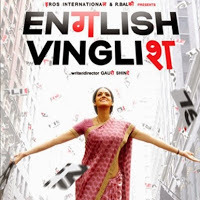 One of last year's most popular feel-good films was Gauri Shinde’s
English Vinglish
, with Sridevi as a diffident, middle-aged woman visiting America and barely knowing how to get by, given her limited knowledge of English. On arriving in New York, she is beset – both on the streets and in her sister’s house – by words spoken in incomprehensible accents, and generally disoriented by the pace of life around her. At one point the film’s music track expresses her state of mind through a melange of sounds coming at her from all directions; meanwhile the title song gently combines English with Hindi in ways that are familiar to most middle-class Indians. (“Badlaa nazaraa yun yun yun / Saara ka saara new new new.”)
One of last year's most popular feel-good films was Gauri Shinde’s
English Vinglish
, with Sridevi as a diffident, middle-aged woman visiting America and barely knowing how to get by, given her limited knowledge of English. On arriving in New York, she is beset – both on the streets and in her sister’s house – by words spoken in incomprehensible accents, and generally disoriented by the pace of life around her. At one point the film’s music track expresses her state of mind through a melange of sounds coming at her from all directions; meanwhile the title song gently combines English with Hindi in ways that are familiar to most middle-class Indians. (“Badlaa nazaraa yun yun yun / Saara ka saara new new new.”)I thought about the hegemony of language again recently while watching scenes in two very different films, scenes that showed how fluency or lack of fluency in a language can affect our perceptions of people: the powerful can seem like underdogs, good guys may appear ridiculous, bad guys almost admirable. The first was Mani Rathnam’s 1987 classic Nayakan , fuelled by Kamal Haasan’s stunning performance as Velu Nayakan, who becomes an underworld don and a godfather to the South Indian community in Bombay. I had an strange moment watching Nayakan: having become immersed in the story, and taken its “Tamil-ness” for granted (this was a clearly South Indian film, I had to read subtitles to understand it), I temporarily forgot that the setting was Bombay, and that people outside Velu’s immediate, enclosed environment speak in Hindi or Marathi.
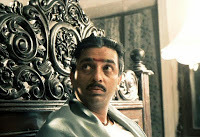 This came home in a scene where Velu – already a well-respected don – has to interact with dons from other parts of the city. Suddenly traces of uncertainty, wariness, even vulnerability, appear on his face as he tries to size up these potential rivals or enemies, whose speech he can’t easily follow. As viewers, we have been thinking of Velu as a larger-than-life figure, firmly in control of his fiefdom, but now we see him in more human terms. There is also something moving about the suggestion that Velu, despite spending almost his entire life in Bombay, never properly learns the city’s majority languages – this gives his situation a nuance that differentiates it from the story of the young Vito Corleone in Little Italy in The Godfather Part II (a film that Nayakan has clear links with), slowly picking up English as he makes his way in the world, so that the transition from the Italian-speaking Vito (played by Robert de Niro) to the English-mumbling patriarch (Marlon Brando) seems wholly natural. Nayakan, on the other hand, gets much of its edge from Velu’s immutable foreignness. No wonder Mani Rathnam expressed dissatisfaction (in one of his interviews with Baradwaj Rangan) with the Hindi remake of the film, Feroz Khan’s Dayavan: the remake was about a Mumbaikar in Mumbai, where he is culturally and linguistically at home, which meant an important subtext about alienation was absent.
This came home in a scene where Velu – already a well-respected don – has to interact with dons from other parts of the city. Suddenly traces of uncertainty, wariness, even vulnerability, appear on his face as he tries to size up these potential rivals or enemies, whose speech he can’t easily follow. As viewers, we have been thinking of Velu as a larger-than-life figure, firmly in control of his fiefdom, but now we see him in more human terms. There is also something moving about the suggestion that Velu, despite spending almost his entire life in Bombay, never properly learns the city’s majority languages – this gives his situation a nuance that differentiates it from the story of the young Vito Corleone in Little Italy in The Godfather Part II (a film that Nayakan has clear links with), slowly picking up English as he makes his way in the world, so that the transition from the Italian-speaking Vito (played by Robert de Niro) to the English-mumbling patriarch (Marlon Brando) seems wholly natural. Nayakan, on the other hand, gets much of its edge from Velu’s immutable foreignness. No wonder Mani Rathnam expressed dissatisfaction (in one of his interviews with Baradwaj Rangan) with the Hindi remake of the film, Feroz Khan’s Dayavan: the remake was about a Mumbaikar in Mumbai, where he is culturally and linguistically at home, which meant an important subtext about alienation was absent.
****
The other scene is a comic one, but provides food for thought too. It is from Quentin Tarantino’s Inglourious Basterds , a wish-fulfilling alternate history in which Nazi hunters save the day during World War II. The villain here is Hans Landa, played by Christoph Waltz: he is terrifyingly smooth, sharp... and a polyglot, which gives him an edge over the good guys, the “Basterds” led by Aldo (Brad Pitt), all of whom are barely fluent in one language, English (more accurately American, spoken in a distinct Southern drawl). One of the film’s funniest scenes has Aldo and team disguised as Italians at a party, while Landa – well aware that they are imposters – toys with them like a cat slowly prying open a box of inauthentic but tasty pasta. (Earlier, when we heard Brad Pitt say “I can speak some Aye-talian” - in response to his German informer contemptuously asking if they know any language other than English - we could tell these boys would soon be treading on thin ice. And so it comes to pass.)
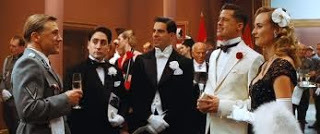 It’s an excellent comic premise, one that combines tension with laughs, and also invites the viewer to consider his own responses to the characters. Here are Aldo and company trying to save the world by infiltrating the dens of the Nazi top brass, and yet they barely understand a word of German. We are supposed to be rooting for them, but they look and behave like hicks – the Three Stooges handed a World War and unsure what to do with it – confirming every stereotype of the insular, ignorant American; in comparison the nasty Landa seems like a higher, more cultured species. We cringe when Aldo says “Bonjourno”, enunciating the word much too deliberately. Then we chuckle when Landa (who seems able to toss off any language as if he were born speaking it) turns out to be a fluent Italian speaker too, and when he deferentially asks the “Italians” if hispronunciation is right. (“Si si, correcto,” Aldo replies, before grunting “Arrividerci” - or "A river derchy" - in a ludicrously fake accent.)
It’s an excellent comic premise, one that combines tension with laughs, and also invites the viewer to consider his own responses to the characters. Here are Aldo and company trying to save the world by infiltrating the dens of the Nazi top brass, and yet they barely understand a word of German. We are supposed to be rooting for them, but they look and behave like hicks – the Three Stooges handed a World War and unsure what to do with it – confirming every stereotype of the insular, ignorant American; in comparison the nasty Landa seems like a higher, more cultured species. We cringe when Aldo says “Bonjourno”, enunciating the word much too deliberately. Then we chuckle when Landa (who seems able to toss off any language as if he were born speaking it) turns out to be a fluent Italian speaker too, and when he deferentially asks the “Italians” if hispronunciation is right. (“Si si, correcto,” Aldo replies, before grunting “Arrividerci” - or "A river derchy" - in a ludicrously fake accent.)Almost in spite of their tomfoolery here, the good guys do eventually get the job done. But when Aldo gets the better of Landa in the film’s last scene, he does it not by winning a verbal duel but by using a knife to carve an incriminating swastika on his adversary’s forehead. The caveman comes out on top because he knows how to use crude tools – and speech be damned.
[Did a version of this for Business Standard. An earlier post here on Tarantino's Django Unchained, in which Christoph Waltz plays another character who uses language so fluidly that everyone around him looks like they've just stumbled in from the Paleolithic]
Published on December 05, 2013 18:00
December 4, 2013
All aboard the Matinee Express (Gaadi bula rahi hai)
[A vignette-ish piece I did for The Indian Quarterly, about train scenes in Indian cinema. Many more films and sequences could have been mentioned, of course - feel free to add to the list]
---------------------
One of the earliest "movies" to be screened – perhaps the most famous of its time – was a 50-second record of a train pulling into a station: the Lumière Brothers’ Arrival of a Train at La Ciotat Station , made in 1895. There is something oddly apt about this early union of locomotive and celluloid, for trains represent movement, and movement was also the unique selling point of those mystical things called motion pictures, which began to haunt people’s dreams towards the end of the 19th century.
No wonder there is a widely told story about viewers leaping out of their seats in terror as the Lumières’ train seemed to head towards them. The story may be exaggerated, but it sounds like it should be true: as a famous linein an American Western (a movie genre that would make significant use of the railroad) put it, “When the legend becomes fact, print the legend.” So let us propose that that train was the first ever movie monster (dare one say “bogie-man”?) – predating filmic depictions of literary characters like Dracula or Frankenstein or Mr Hyde, not to mention the thousands of monsters that were first dreamt up for cinema.
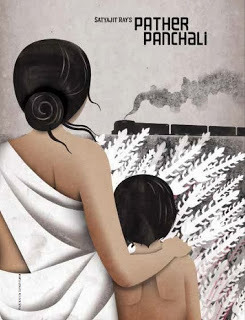 (Illustration by SOMESH KUMAR)
(Illustration by SOMESH KUMAR)Might Satyajit Ray have had this in mind when he employed train imagery to such sinister effect in the Apu Trilogy? There are scenes in Pather Panchaliand Aparajito – visualisations of Ray’s carefully drawn storyboards – where a train seen in the distance, moving across the landscape, resembles a venomous black serpent. In these scenes, the locomotive with its trailing plumes of smoke also reminds me of the hooded Grim Reaper wielding his scythe in another film of the era, Ingmar Bergman’s The Seventh Seal . And indeed, the
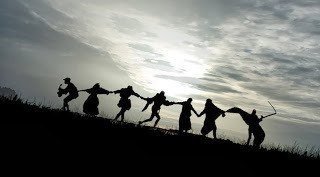 trains in these early Ray films are closely linked to death: the young protagonist Apu frequently suffers the loss of people he loves, beginning with his sister Durga – with whom he waits in the fields for a glimpse of the passing train.
trains in these early Ray films are closely linked to death: the young protagonist Apu frequently suffers the loss of people he loves, beginning with his sister Durga – with whom he waits in the fields for a glimpse of the passing train. In the larger context of modern Indian history, trains have another very dark association: the most vivid horror stories about Partition involve ghost trains containing massacred bodies, moving back and forth across the newly created border, and there have been echoes in more recent tragedies like the 2002 Godhra train massacre. Ray’s contemporary Ritwik Ghatak was among the few directors who used trains – in films such as Megha Dhaka Tara – to emphasise fractured relationships in a country divided along communal lines.
However, making trains a representation of a single idea would be folly: it is equally possible to see them as the things that bind a large and complex nation. If they can be tied to death and destruction, they can also stand for development – the development of an individual, or of society itself. Remember that it is on a train that Apu travels to a life with bright new possibilities, from village to city. And consider how one of our most iconic films, Sholay , is book-ended by shots of moving trains. The opening scene has a train coming towards the camera (a nod to the Lumières?) before the camera moves forward to meet it, almost like an impatient family
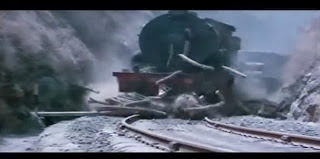 member. Sholayowes a big debt to the Western, and in that genre the railroad was a symbol of progress and civilisation. Little wonder then that the film's first action sequence has Veeru and Jai proving their heroism (and their status as “good guys”) by fighting off bandits who are trying to pillage a train. Not long after this, a train will carry the two men to a station near Ramgarh village, where the epic confrontation between good and evil will take place.
member. Sholayowes a big debt to the Western, and in that genre the railroad was a symbol of progress and civilisation. Little wonder then that the film's first action sequence has Veeru and Jai proving their heroism (and their status as “good guys”) by fighting off bandits who are trying to pillage a train. Not long after this, a train will carry the two men to a station near Ramgarh village, where the epic confrontation between good and evil will take place.****
Incidentally, though trains play an important function in Sholay, I find it difficult to picture Gabbar Singh traveling in one. Being a representation of primal evil, Gabbar inhabits a universe very different from that of the modern railroad. He lords it over his minions in a sun-baked, rocky valley far from the civilised world, trades with gypsies, and is associated with the outdoors; enclosed spaces, be they prison cells or train compartments, cannot contain him.
But let’s stage a little drama of our own now. Let’s imagine a special cinematic train – the Matinee Express? – made up of as many compartments as we could possibly need, and with no attempt at internal consistency. Thus, one section of this train could be a luxurious, velvet-curtained, gliding hotel of the sort that Anna Karenina would make an overnight journey on, but there would also be the squalid, overcrowded compartments that are so familiar to almost anyone who has traveled by train in India. And the people in this imaginary vehicle would represent different character types and situations, all filtered through our cinematic memories.
And let us begin with a contrast in moods, as exemplified by two songs. Sitting in one of the first compartments is Maanav, played by Dharmendra in the 1974 film Dost, and the song in his head is the beautiful “Gaadi Bula Rahi Hai”, which uses a train as an inspiration to draw the best from life: “Chalna hee zindagi hai / Chalti hee jaa rahee hai” (Life means movement / the train keeps moving). As our locomotive enters and exits hillside tunnels, the song exhorts young people to learn the following lesson: the train has fire in its belly, it toils away and bellows smoke (“Sar pe hai bojh / seene mein aag”), yet it continues to sing and whistle (“phir bhi yeh gaa rahi hai / nagme suna rahi hai”). What better analogy can there be for working hard and honestly, and staying upbeat as well?
But further back in another compartment, looking mournfully out the window, is a less sanguine hero from that same year, Kamal (Rajesh Khanna) in Aap Ki Kasam, and a less upbeat tune: “Zindagi ke safar mein guzar jaate hain jo makaam / woh phir nahin aate” (In life’s journey, when you leave a place behind / you never see it again). Here again, life is presented as a train journey, but one where each departing station represents something that has been irretrievably lost.
Since time travel is no constraint on our fantasy journey, let’s go back a few decades to the early 1950s and make room for a villager named Shambhu, who is eager to clamber into the cattle-class section. The hero of Bimal Roy’s Do Bigha Zamin is on his way to the big city to earn enough money to pay off a debt – at this point the train is for him a vessel to a better, more fulfilling life, so we won’t tell him that his illusions will soon be shattered. Instead, we’ll allow him a few hours of grace in the company of his little son, who is stowed away on our Matinee Express because he wanted to be with his father, but also because of the sheer novelty of being on a train: “Calcutta toh rail gaadi se jaana hoga, na?” he asks. (We can only travel to Calcutta by train, right?)
 When hard reality does strike, Shambhu might be demoted to the Bogie of Lost Travelers. This is a purgatory for forgotten souls – for people who are trying to escape from themselves – and here all differences of class and background melt away. Thus, in one corner sit the many Devdases of our movie heritage, accompanied by their faithful but despairing servants. This is the tragic protagonist’s last journey: just as it seems like he might yet be able to redeem himself, the train stops at a station and he encounters his old friend Chunnilal, who does nothing more useful than tempt our hero into another fatal drinking session.
When hard reality does strike, Shambhu might be demoted to the Bogie of Lost Travelers. This is a purgatory for forgotten souls – for people who are trying to escape from themselves – and here all differences of class and background melt away. Thus, in one corner sit the many Devdases of our movie heritage, accompanied by their faithful but despairing servants. This is the tragic protagonist’s last journey: just as it seems like he might yet be able to redeem himself, the train stops at a station and he encounters his old friend Chunnilal, who does nothing more useful than tempt our hero into another fatal drinking session. Elsewhere in the Lost Travelers’ compartment is a less central character from another major film, Deewaar: the disgraced trade unionist Anand Verma, father of the film’s heroes Vijay (Amitabh Bachchan) and Ravi (Shashi Kapoor). Anand left his family when his children were little; many years later, when they are young men, their destinies firmly set on opposite sides of the law, his corpse is discovered on a train and we realise he has spent half his life shunting aimlessly from one station to another. This means he has probably covered the country a thousand times over, but it scarcely matters: for Anand Verma, Devdas and their sad brethren, the train is a moving coffin, not the means to a destination but the destination itself.
****
Enough morbidity; let’s get some positive energy into our chook-chook now. There is place in this cinematic fantasy for double and triple roles, and so, as we pass under another bridge, we can see another Dharmendra – the Shankar of Yaadon ki Baarat – looking down at us thoughtfully. Just a few seconds earlier, this character was a young boy standing at exactly the same spot on the bridge, but then a 360-degree camera movement (which also showed the train passing below) allowed him to morph into the man. Perhaps this is an example of the train as a metaphor for growth – after all, there is no dearth of scenes in those action-hero-centred movies of the 1970s and 80s where a fleeing child leaps off a bridge onto the train running underneath; when his feet hits the top of the compartment, he is the grown-up hero.
That said, trains might also permit one to go in the opposite direction, to regress into childhood – and who is this man-child in half-pants, licking at a lollipop, hopping aboard our rail-gaadi? It is the Vijay (Kishore Kumar) of Half Ticket, who has disguised himself as a child because he doesn’t have the train fare for an adult. We recognise the deception, but we’ll let him in; his presence will provide some entertainment during our ride, and serve as a reminder that trains can be mobile amusement parks if you have the right company and a sense of humour.
Having stopped briefly at that last station, the Matinee Express is now pulling away, but not at great speed, which is just as well, for a soulful young man is posing dramatically at the door, stretching his hand out. A few suspenseful moments later another, softer hand meets his and a young woman is pulled onto the coach and into his arms. Rahul (Shah Rukh Khan) and Simran (Kajol) of Dilwale Dulhaniya le Jaayenge are on their way to a bright future together, and it scarcely matters to us (being allies of young romance) that she hasn’t bought a ticket.
Elsewhere, a more discreet romance is being conducted between Vandana (Sharmila Tagore), the demure heroine of Aradhana, and a dashing air force officer named Arun (Rajesh Khanna); she is in a special mini-compartment, reading or pretending to read - Alistair MacLean, no less - while he is in an open jeep passing on the road outside, and flowing between them is the song “Mere Sapnon Ki Rani”. But Sharmila Tagore must be allowed one more role in our improbable mise-en-scène, so here she is again, more serious-looking, as a magazine editor named Aditi, who confronts a film star named Arindam (Uttam Kumar) and makes him face his private demons. The film is Satyajit Ray’s Nayak, and mark the contrast from the Apu Trilogy: the director appears to have got over his fear of train-travel and is now using one as a setting for personal therapy. Not long after this, he will even set part of his rollicking adventure Sonar Kella – with the detective Feluda pursuing villains from Bengal to Rajasthan – on a train.
Speaking of adventure, one of the most sustained train movies we have ever had – where most of the action takes place in a train and the plot centres on a super-fast train too – is B R Chopra’s The Burning Train , which was a big-budget disaster movie in the Hollywood tradition while also being a shining tribute to the railways and to Indian unity. Having made sure that our magic train has a generous supply of fire extinguishers, I’m now going to allow some of the characters from that film on board.
They represent the many colours of India, so here are a Hindu priest and a Muslim maulvi who initially bicker but later find common ground. Here is a Catholic schoolteacher escorting a tribe of children, and a loud-voiced but genial Sardarji. With this motley crew, who can resist a few songs? But with the arrival of the villains, our heroes are forced to climb outside the speeding vehicle and onto the roof of the compartment, where a battle for life and death will ensue.
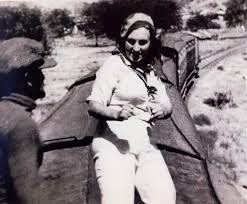 Watching them from the distance of a few compartments – and the span of more than 40 years – with a little smirk on her face is Fearless Nadia, who has seen and done all this before these boys were even born. Among the earliest of her films was Miss Frontier Mail (1936), its title derived from the real Frontier Mail of the era, which – as Rosie Thomas puts it in an essay about Nadia – was “the height of glamorous modernity, its name synonymous with speed, adventure and the sophistication of the railways”. Nadia brought an element of chaos to that sophistication as she fought baddies on train rooftops, and her films also drew intriguing parallels between a speedy train and a fast-modernising world, where a woman could do all the things that fell traditionally in the male domain (and do them twice as well).
Watching them from the distance of a few compartments – and the span of more than 40 years – with a little smirk on her face is Fearless Nadia, who has seen and done all this before these boys were even born. Among the earliest of her films was Miss Frontier Mail (1936), its title derived from the real Frontier Mail of the era, which – as Rosie Thomas puts it in an essay about Nadia – was “the height of glamorous modernity, its name synonymous with speed, adventure and the sophistication of the railways”. Nadia brought an element of chaos to that sophistication as she fought baddies on train rooftops, and her films also drew intriguing parallels between a speedy train and a fast-modernising world, where a woman could do all the things that fell traditionally in the male domain (and do them twice as well).If the open spaces atop trains are perfect setting for such fight sequences – or for the equally rambunctious performance of such songs as “Chhaiya Chhaiya” (Dil Se...), the interiors of trains can be closed and claustrophobic, and thus effective settings for suspense or intrigue. (Think Hitchcock’s The Lady Vanishes or Agatha Christie’s Murder on the Orient Express.) One of our fellow passengers – sitting by himself in an overcoat – is an intense young man with a preoccupied look on his face. This is Kumar (Amitabh Bachchan) of Parwana (1971), who is using this train journey as part of an elaborate alibi that will enable him to commit murder without being found out.
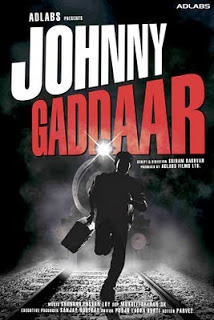 But in the very same compartment, unbeknownst to him, is his admirer and doppelganger, the title character in
Johnny Gaddaar
(2007) who was so inspired by the plot of Parwana that he employs a similar technique to pull off a complicated heist.
But in the very same compartment, unbeknownst to him, is his admirer and doppelganger, the title character in
Johnny Gaddaar
(2007) who was so inspired by the plot of Parwana that he employs a similar technique to pull off a complicated heist. Of course, all our characters don’t actually have to be on board – some very poignant movie moments involve people who are seeing off other people but going nowhere themselves. Notable among these is Salim Mirza (Balraj Sahni) in Garm Hava , standing ramrod straight, bravely concealing his sorrow as one family member after another leaves him for the freshly created country across the post-Partition border. And there is the armless Thakur in a similar pose at the end of Sholay, his own life barren as the desert, but watching others move on with theirs, as the train carrying Veeru and Basanti pulls out of the station. Or think of the metaphoric use of the railway station waiting room as a crossroad: in Gulzar’s Ijaazat, a divorced couple named Mahender (Naseeruddin Shah) and Sudha (Rekha) re-encounter each other and exchange memories and revelations. We never see either of them getting on to a train, and we don’t need to.
I’m going to exercise an engineer’s licence here and permit our fantasy train to have a few compartments that are meant only for very short-distance traveling and can be detached from the whole - for these are the local city trains or the metros, and the kinds of plots that unfurl within them are necessarily different from the ones that take place in languid, long-distance travel. The time that passengers get to spend together per journey is limited, but it is possible to meet every day, and for a romance to unfurl slowly: thus the burgeoning of the relationship between working-class boy Tony (Amol Palekar) and the sweet Nancy (Tina Munim), chaperoned by her uncle, takes place on a Bandra-Churchgate route in Baaton Baaton Mein, as they move from passing notes to direct conversation.
There are opportunities, but there are threats too, as we are reminded in A Wednesday, which depicts the frustrations of the train-travelling common man in a world afflicted by terrorist strikes, and in Kahaani, which begins with a scene showing a chemical attack on a metro – and later has a scene where the film’s protagonist almost finds herself hurled before an oncoming train. This is why the staff of our Matinee Express is so meticulous about their security checks. Kindly excuse the inconvenience.
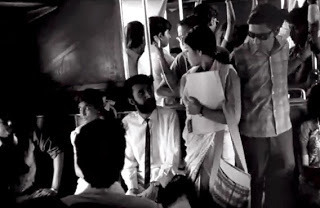 One man who moves freely from one coach to the next is a ticket-collector named Sanjay (M K Raina), from the low-key 1973 film 27 Down, and watching him is a reminder that so few of our movies have had interesting protagonists who work in the railways. (Need one mention the Bachchan-starrer Coolie here?) Sanjay is the quiet, subdued type, but there’s a lot going on inside his head. He didn’t want this job – he had to give up his art studies because of his railway-employee father’s insistence – and now he feels like he has spent his life crossing bridges without really getting anywhere; he lives, literally and figuratively, on the tracks, and measures his life in train sounds and distances. In fact, the first words we hear in the film are his subconscious musings: “Phir koi pull hai kya? Shaayad pull hee hai” (Has another bridge come? Seems like it).
One man who moves freely from one coach to the next is a ticket-collector named Sanjay (M K Raina), from the low-key 1973 film 27 Down, and watching him is a reminder that so few of our movies have had interesting protagonists who work in the railways. (Need one mention the Bachchan-starrer Coolie here?) Sanjay is the quiet, subdued type, but there’s a lot going on inside his head. He didn’t want this job – he had to give up his art studies because of his railway-employee father’s insistence – and now he feels like he has spent his life crossing bridges without really getting anywhere; he lives, literally and figuratively, on the tracks, and measures his life in train sounds and distances. In fact, the first words we hear in the film are his subconscious musings: “Phir koi pull hai kya? Shaayad pull hee hai” (Has another bridge come? Seems like it). If this hard-working young man were to take a cigarette break by going to the very end of the train and standing outside the last bogie, he might see that the stones on the track are forming words! Unfolding here is the inventive opening-credits sequence of Vijay Anand’s Chhupa Rustam where the names of the cast and crew members are spelt out in white chalk on the pebbles that litter the rail tracks.
If this hard-working young man were to take a cigarette break by going to the very end of the train and standing outside the last bogie, he might see that the stones on the track are forming words! Unfolding here is the inventive opening-credits sequence of Vijay Anand’s Chhupa Rustam where the names of the cast and crew members are spelt out in white chalk on the pebbles that litter the rail tracks.It's a very odd sight, but we should be used to that by now. The fact that our train has enough space in it for both the melancholy ticket-collector and for the boisterous hero dancing to “Chhaiya Chhaiya” – along with so many others in between – is a reminder of the variety in both cinema and in rail travel. And so, while the Matinee Express continues on its merry way – picking up and dropping off more passengers along its endless line – I’ll give the last word to that very unlikely rap star, Jogi Thakur (Ashok Kumar), from the 1968 film Aashirwad.
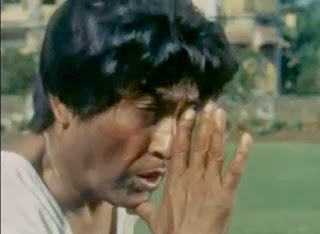 He isn’t on board our train, but think of him as a sort of ringmaster, perpetually moving alongside it, commenting on the journey, giving voice to the stations that implore us to stop (“Rail gaadi / chuk chuk chuk / Beech waale station bole / ruk ruk ruk”) but also describing the scenery and people outside (“Buddhaa kisaan / hara maidan / mandir makaan / chai ki dukaan” – An old farmer / a green field / a temple and a house / a tea-shop) and ending with a list of cities and towns that this train will pass through. But we could equally think of him as a relic from our cinematic past, asking the train not to move too fast, to not try to compete with a world of jet planes. After all, we live in a time of diminishing attention spans, reduced travel time... and smaller screens too. (Could the audience at those Lumière films have possibly imagined watching movies on a mobile phone?) And so, it’s good to be reminded that life can still occasionally be both leisurely and king-sized – a view of a picturesque landscape through a train's windows, unfolding like an epic film on an old-fashioned 70mm screen.
He isn’t on board our train, but think of him as a sort of ringmaster, perpetually moving alongside it, commenting on the journey, giving voice to the stations that implore us to stop (“Rail gaadi / chuk chuk chuk / Beech waale station bole / ruk ruk ruk”) but also describing the scenery and people outside (“Buddhaa kisaan / hara maidan / mandir makaan / chai ki dukaan” – An old farmer / a green field / a temple and a house / a tea-shop) and ending with a list of cities and towns that this train will pass through. But we could equally think of him as a relic from our cinematic past, asking the train not to move too fast, to not try to compete with a world of jet planes. After all, we live in a time of diminishing attention spans, reduced travel time... and smaller screens too. (Could the audience at those Lumière films have possibly imagined watching movies on a mobile phone?) And so, it’s good to be reminded that life can still occasionally be both leisurely and king-sized – a view of a picturesque landscape through a train's windows, unfolding like an epic film on an old-fashioned 70mm screen.
Published on December 04, 2013 04:19
November 30, 2013
On Colm Tóibín's The Testament of Mary
[Have taken a break from book-reviewing for various reasons, but here's one I did for the Hindu Literary Review]
In contemporary fiction, the retelling of old stories – myths, folklore and religious texts among them – has become almost a genre unto itself. There have been countless revisionist versions of the Mahabharata or Ramayana in India, including “perspective” narratives that filter events through the eyes of a particular character. Done well, this gives us new lenses through which to see familiar stories we had taken for granted, or grown weary of; in the process, we may also understand something about how legends come into being and then become buttressed and sanctified through repetition over the centuries.
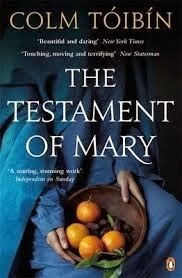 In his slim new book, the Irish writer Colm Tóibín, whose 2004 novel The Master was a fictionalised treatment of a key period in Henry James’s life, turns to a more distant story that is both shrouded in mist and set in stone. The Testament of Mary is an account of certain episodes in Jesus Christ’s life, as told in the confused, plaintive voice of his mother Mary, long after the crucifixion. That the old woman we encounter in these pages will be a de-mythologised version of the Holy Virgin is obvious almost from the opening paragraph: Mary speaks of men who visit her repeatedly, trying to gather anecdotes and recollections ("I like it that they feed me and pay for my clothes and protect me"), and we can tell that these are apostles engaged in the process of myth-making, collecting material for their books. But the narrative she tells, finally, is not to them – it is to us, and throughout Tóibín keeps us aware that this is as much a story as the “official” ones handed down over thousands of years.
In his slim new book, the Irish writer Colm Tóibín, whose 2004 novel The Master was a fictionalised treatment of a key period in Henry James’s life, turns to a more distant story that is both shrouded in mist and set in stone. The Testament of Mary is an account of certain episodes in Jesus Christ’s life, as told in the confused, plaintive voice of his mother Mary, long after the crucifixion. That the old woman we encounter in these pages will be a de-mythologised version of the Holy Virgin is obvious almost from the opening paragraph: Mary speaks of men who visit her repeatedly, trying to gather anecdotes and recollections ("I like it that they feed me and pay for my clothes and protect me"), and we can tell that these are apostles engaged in the process of myth-making, collecting material for their books. But the narrative she tells, finally, is not to them – it is to us, and throughout Tóibín keeps us aware that this is as much a story as the “official” ones handed down over thousands of years.Unlike another recent retelling, Philip Pullman’s The Good Man Jesus and theScoundrel Christ – told by an omniscient narrator and in the gentle, dialogue-driven cadences of a tale read out to young readers – The Testament of Mary is an intense first-person narrative that comes to resemble interior monologue. The prose has the stillness that marks Tóibín’s best work – the effect is a little like watching incoming waves on a sea-shore, knowing that the soft murmurs might soon turn into something louder, more strident – and naturally, given the subject matter, it is run through with melancholia, the need to remember set against the pain of remembering.
The voice we get here is the one of a mother befuddled by all this talk of her boy being the “Son of God”; a woman who doesn’t care about the big picture, who wishes only that time could be turned back to the days when she and her child and husband were happy together, untouched by the burden of divinity. But it is also the wise, knowing gaze of someone fearful of the things that happen when groups of men – social misfits, who cannot look a woman in the eye, who need a form of validation, and are driven by those twin qualities, “foolishness and cruelty” – gather together. Do such herds inevitably beget cults of violence, or lead to the formation of a new religion, or both? It is a question that hangs over this book, without being explicitly stated.
Being treated as the mother of the Messiah is frightening for Mary, especially as she senses that attempts are being made to co-opt her into the creation of legends. Recalling the famous incident at the Cana wedding, she insists she had nothing to do with the water-into-wine “miracle” (in her telling, Jesus’s remark “Woman, what have I to do with thee?” was made in another context), but that his followers focused their attention on her as if willing her to be part of the episode. Hence the mundane and unglamorous view of big events such as the sermons (“...my son would insist on silence and begin to address them as though they were a crowd, his voice all false and his tone all stilted, and I could not bear to hear him, it was like something grinding...”) or the rise of Lazarus, presented here in ambiguous terms. Hence her recollection of watching her son’s final, painful journey to the hill, his attempts to remove the crown of thorns from his head, and of her own guilt of leaving him on the cross to bear the last moments of his Passion alone. Her searing admission that despite everything she witnessed and felt, ultimately “the pain was his and not mine”, is a poignant counterpoint to the conceit of one man dying for the sins of a race.
The is a quiet book on the face of it, but there is tumult beneath its surface – not the obvious violence of nails being driven into a man’s hands but the violence of pattern-seeking narratives imposing themselves on and bullying “ordinary” lives, so that the world of dreams is the only remaining place where some grace may be found. “I want to be able to imagine that what happened to him will not come, it will see us and decide – not now, not them,” Mary says, “And we will be left in peace to grow old.”
Published on November 30, 2013 07:43
Jai Arjun Singh's Blog
- Jai Arjun Singh's profile
- 11 followers
Jai Arjun Singh isn't a Goodreads Author
(yet),
but they
do have a blog,
so here are some recent posts imported from
their feed.



